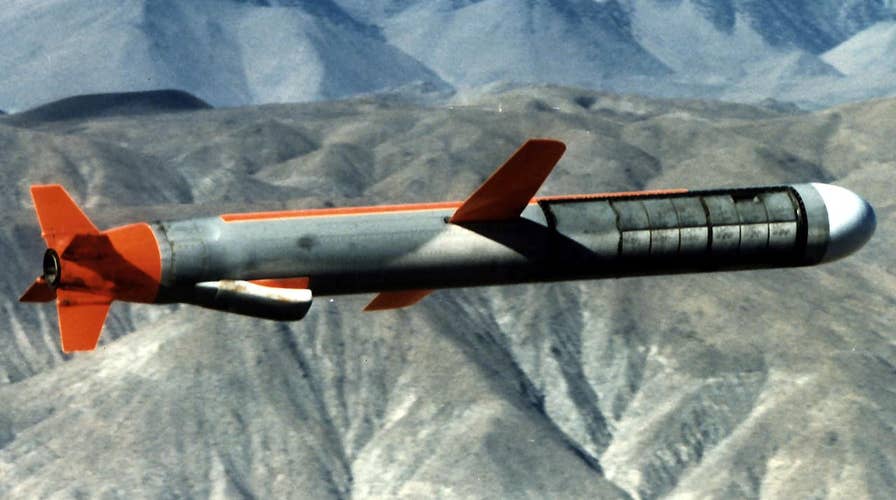What is a Tomahawk missile?
The subsonic, jet-powered missiles are low-flying and cruise at a speed around 550 mph
The United States fired nearly 60 Tomahawk cruise missiles at a Syrian airfield early Friday in response to a chemical weapons attack earlier this week that killed dozens of civilians.
The cruise missiles were fired from both USS Porter and USS Ross, a U.S. official told Fox News. The missiles were the latest model: the Tomahawk “E” or Echo version, defense officials said.

A Tomahawk cruise missile fired in the Mediterranean Sea, in a 2011 Navy photo. (REUTERS/Jonathan Sunderman/U.S. Navy//Handout)
The missiles have two-way satellite communication allowing reprogramming in flight if needed.
A top military contractor, Massachusetts-based Raytheon, makes the Tomahawks. On the missile manufacturer’s website, they call today’s model, “Modern, Mature, Powerful,” adding that it can “circle for hours, shift course instantly on command and beam a picture of its target to controllers halfway around the world before striking with pinpoint accuracy.”
US LAUNCHES MISSILES INTO SYRIA IN RESPONSE TO CHEMICAL WEAPONS ATTACK
The Tomahawk has been in use since the Persian Gulf War in 1991, and carries a 1,000-pound-class warhead. Each missile costs more than $1 million.
The cruise missiles are designed to fly at extremely low altitudes at high subsonic speeds, and are piloted over an evasive route by several mission-tailored guidance systems, according to the Navy.
Tomahawk missiles can be launched from Navy destroyers up to 1,000 miles away, providing a strategic attack option when facing an enemy's jets in the air, The Washington Post reports. Raytheon’s website says, “launching the weapon from such a long distance helps to keep sailors out of harm's way.”
Former commanding officer of the U.S.S. Cole, Kirk Lippold told Fox and Friends on Friday that the U.S. forces aboard the destroyers were well prepared. “Before they even deployed, they spent months getting trained and certified in being able to fire these weapons,” he said. “They are very familiar with the procedures, for any incidence that may occur, misfires, rapid changes in targeting.”
SYRIA AIRSTRIKES: TRUMP SAYS MILITARY ACTION IN 'VITAL NATIONAL SECURITY INTEREST'
While the cruise missiles that hit Syria were launched from two US Navy surface ships, one of the most intriguing platforms than can fire the Tomahawk is the submarine. Specifically, converted ballistic missile submarines. Four Ohio-class guided-missile submarines, originally designed to launch nuclear missiles, were converted between 2003 and 2007.
The USS Florida (SSGN 728) was converted in August 2003, the USS Michigan (SSGN 727) in October 2004, the USS Ohio (SSGN 726) in December 2005, and the USS Georgia (SSGN 729) in December 2007. According to the U.S. Navy, “combined, the four SSGNs represent more than half of the Submarine Force's vertical launch payload capacity with each SSGN capable of carrying up to 154 Tomahawk land-attack cruise missiles”. Additionally, the converted submarines can carry and deploy as many as 66 special operations personnel.
In contrast the USS Porter and Ross, combined, can carry up to 90 Tomahawks each. The four converted submarines can carry up to 616 tomahawk missiles, or over ten times the number launched on Syria. Adding up to as 265 special operators, like Navy SEALs, and these sea going vessels are, according to the Navy, “land attack and SOF [Special Operation Forces] platforms.”
Lippold explained that the Tomahawk is so precise, that with the help of G.P.S. technology, it could target and strike the 10th floor of a building. “It is a very accurate weapon and the reason we want to use that, obviously, is to nail the target and not have the civilian casualties” that come with setting off large bombs.
The missiles were last used in October, when the military launched strikes in Yemen against three coastal radar sites in Yemen after Houthi rebels there fired missiles at several U.S. ships over several days.
Fox News' Lucas Tomlinson and Jennifer Griffin contributed to this report.





















